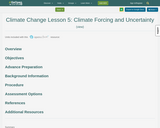
Students identify the factors which can influence climate change and identify reasons for uncertainty.
- Subject:
- Applied Science
- Environmental Science
- Material Type:
- Activity/Lab
- Lesson Plan
- Date Added:
- 12/06/2019

Students identify the factors which can influence climate change and identify reasons for uncertainty.
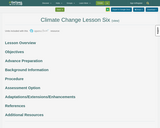
Students graph atmospheric carbon dioxide, emissions of carbon dioxide, and temperature throughout the years and compare the trends.
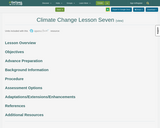
Students explore the basis of models which project climate change.
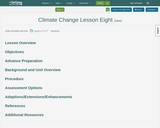
Students synthesize evidence about climate change, specifically in the Great Lakes region, and explore its potential impacts.
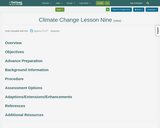
In this two-part lesson, students first explore phenological changes through an analysis of phenological observations. In part two students examine the effects of seasons
with longer degree days and spring freeze, and consider projections into the future, focusing their efforts on tart cherry production in Michigan.
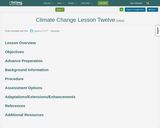
Students will review potential impacts of climate change on Michigan and determine both adaptive and individual mitigation strategies. Through an optional service learning project, they will get the word out about climate change and that actions can be taken to reduce emissions of greenhouse gases.
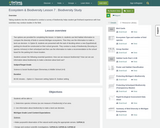
Taking students into the schoolyard to conduct a survey of biodiversity helps student get firsthand experience with how scientists may conduct studies in the field.

An active, high-energy game, where students role-play parts of the ecosystem as producers, herbivores, carnivores, and decomposers. This activity can also be used to simulate the bioaccumulation of toxins.

Students take a short field trip into the schoolyard for a scavenger hunt to reinforce understanding of terms and concepts (producer, consumer, decomposer, food chain, predator/prey, photosynthesis) used in Lesson 2.

Students become familiar with threatened and endangered plant and animal species of Michigan. Students learn what it means to be listed as threatened or endangered, common causes for being listed, and the role of government and individuals in protecting biodiversity.
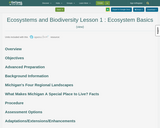
Students first consider what supports all life on Earth
and are then introduced to the levels of environmental
organization (biosphere, biome, ecosystem, community,
population, and organism).

Students take a short field trip into the schoolyard for a scavenger hunt to find examples of nonliving (abiotic) and living (biotic) ecosystem components, including organisms, habitat, population, community, ecosystem, sunlight, water, temperature, nutrients, and wind. This activity can be used as an informal assessment for Lesson 1.
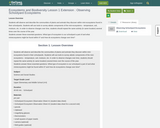
Students will observe and describe the communities of plants and animals they discover within mini-ecosystems found in their schoolyards. Students will use tools to survey abiotic components of the mini-ecosystems – temperature, soil, moisture, etc. In order to observe changes over time, students should repeat the same activity (in same location) several times over the course of the year.Students answer these essential questions: What type of ecosystem is our schoolyard a part of and what miniecosystems might be found within it? and How do ecosystems change over time?
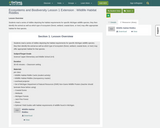
Students read a series of riddles depicting the habitat requirements for specific Michigan wildlife species; they then identify the animal as well as which type of ecosystem (forest, wetland, coastal dune, or river) may offer appropriate habitat for that species.

In this activity students will identify where the ingredients in a tomato and cheese sandwich originated. They will trace a food item from its place as a sandwich ingredient to where it was originally grown. Students then suggest ways that people can minimize their impact on ecosystems and biodiversity by making informed decisions about food choices.
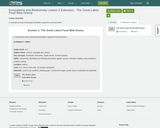
A read-aloud script introducing freshwater organisms and food webs

This two-part activity provides reinforcement in understanding the terms producer, consumer, decomposer, predator, prey, and food chain. In the first part, students become familiar with how these terms can be used to classify living things; they then formulate questions using the terms. In the second part, students utilize the related vocabulary to participate in a guessing game.
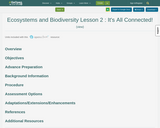
Students work in small groups to research, identify, and label food webs on the Michigan DNR Non-Game Wildlife posters. Students then predict the possible consequences of removing one component of the food web.
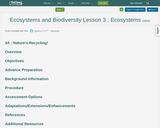
Students first consider that there is a finite amount of matter on Earth and that life here is dependent on the continuous recycling and reuse of nutrients found in the planet’s air, water, and soil. Students then focus on how water is cycled within the environment. Students are introduced to the hydrologic cycle and then participate in an investigation related to transpiration. While it is recommended that the investigation in step 3 be completed outdoors, it may alternatively be completed indoors.
An extension lesson, Water Wonders (found on the MEECS Ecosystems & Biodiversity CD) is provided as an additional resource for further exploring the water cycle.

Students look for (and document) evidence of the water cycle, photosynthesis, and decomposition in the schoolyard. Students should have prior experience with these processes before doing this activity. This activity can be used as a culminating activity for Lesson 3, Parts A-C.Students answer the essential question: What evidence of the water cycle, photosynthesis, and decomposition can we find in the schoolyard?